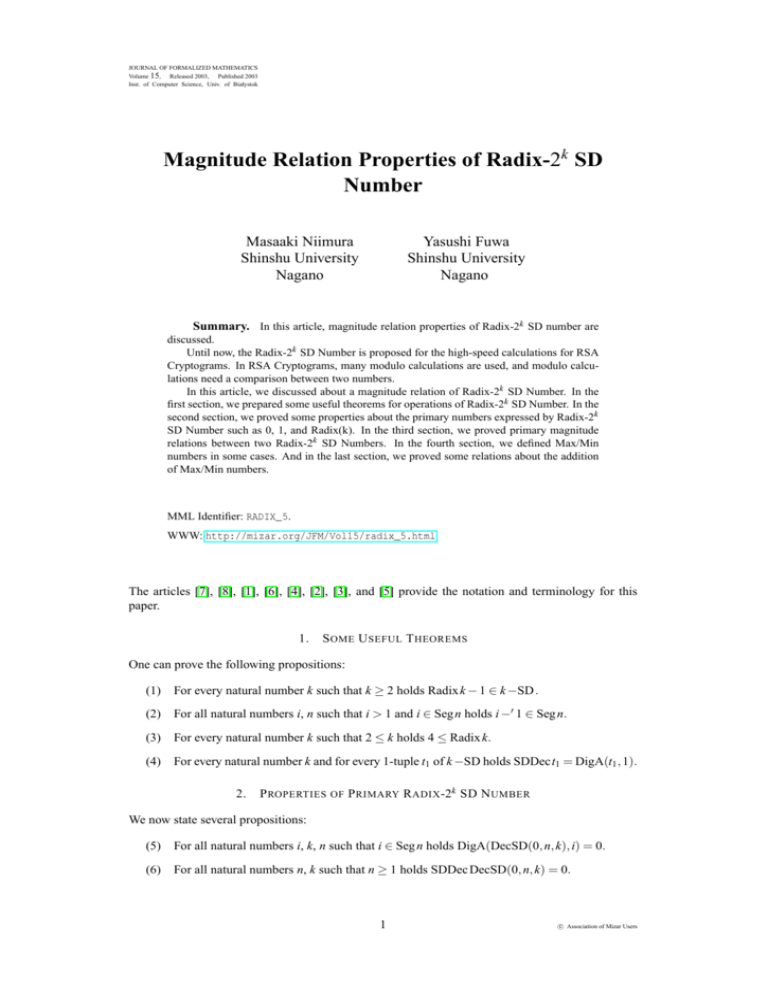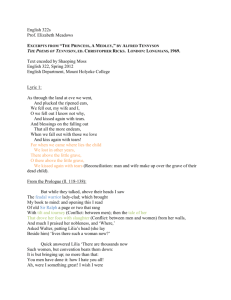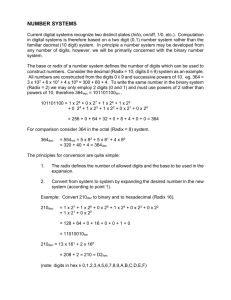Magnitude Relation Properties of Radix
advertisement

JOURNAL OF FORMALIZED MATHEMATICS Volume 15, Released 2003, Published 2003 Inst. of Computer Science, Univ. of Białystok Magnitude Relation Properties of Radix-2k SD Number Masaaki Niimura Shinshu University Nagano Yasushi Fuwa Shinshu University Nagano Summary. In this article, magnitude relation properties of Radix-2k SD number are discussed. Until now, the Radix-2k SD Number is proposed for the high-speed calculations for RSA Cryptograms. In RSA Cryptograms, many modulo calculations are used, and modulo calculations need a comparison between two numbers. In this article, we discussed about a magnitude relation of Radix-2k SD Number. In the first section, we prepared some useful theorems for operations of Radix-2k SD Number. In the second section, we proved some properties about the primary numbers expressed by Radix-2k SD Number such as 0, 1, and Radix(k). In the third section, we proved primary magnitude relations between two Radix-2k SD Numbers. In the fourth section, we defined Max/Min numbers in some cases. And in the last section, we proved some relations about the addition of Max/Min numbers. MML Identifier: RADIX_5. WWW: http://mizar.org/JFM/Vol15/radix_5.html The articles [7], [8], [1], [6], [4], [2], [3], and [5] provide the notation and terminology for this paper. 1. S OME U SEFUL T HEOREMS One can prove the following propositions: (1) For every natural number k such that k ≥ 2 holds Radix k − 1 ∈ k −SD . (2) For all natural numbers i, n such that i > 1 and i ∈ Seg n holds i −0 1 ∈ Seg n. (3) For every natural number k such that 2 ≤ k holds 4 ≤ Radix k. (4) For every natural number k and for every 1-tuple t1 of k −SD holds SDDect1 = DigA(t1 , 1). 2. P ROPERTIES OF P RIMARY R ADIX -2k SD N UMBER We now state several propositions: (5) For all natural numbers i, k, n such that i ∈ Seg n holds DigA(DecSD(0, n, k), i) = 0. (6) For all natural numbers n, k such that n ≥ 1 holds SDDec DecSD(0, n, k) = 0. 1 c Association of Mizar Users MAGNITUDE RELATION PROPERTIES OF RADIX -2k ... 2 (7) For all natural numbers k, n such that 1 ∈ Seg n and k ≥ 2 holds DigA(DecSD(1, n, k), 1) = 1. (8) For all natural numbers i, k, n such that i ∈ Seg n and i > 1 and k ≥ 2 holds DigA(DecSD(1, n, k), i) = 0. (9) For all natural numbers n, k such that n ≥ 1 and k ≥ 2 holds SDDec DecSD(1, n, k) = 1. (10) For every natural number k such that k ≥ 2 holds SD Add Carry Radix k = 1. (11) For every natural number k such that k ≥ 2 holds SD Add Data(Radix k, k) = 0. 3. P RIMARY M AGNITUDE R ELATION OF R ADIX -2k SD N UMBER The following propositions are true: (12) Let n be a natural number. Suppose n ≥ 1. Let k be a natural number and t1 , t2 be n-tuples of k −SD. If for every natural number i such that i ∈ Seg n holds DigA(t1 , i) = DigA(t2 , i), then SDDect1 = SDDect2 . (13) Let n be a natural number. Suppose n ≥ 1. Let k be a natural number and t1 , t2 be n-tuples of k −SD. If for every natural number i such that i ∈ Seg n holds DigA(t1 , i) ≥ DigA(t2 , i), then SDDect1 ≥ SDDect2 . (14) Let n be a natural number. Suppose n ≥ 1. Let k be a natural number. Suppose k ≥ 2. Let t1 , t2 , t3 , t4 be n-tuples of k −SD. Suppose that for every natural number i such that i ∈ Seg n holds DigA(t1 , i) = DigA(t3 , i) and DigA(t2 , i) = DigA(t4 , i) or DigA(t2 , i) = DigA(t3 , i) and DigA(t1 , i) = DigA(t4 , i). Then SDDect3 + SDDect4 = SDDect1 + SDDect2 . (15) Let n, k be natural numbers. Suppose n ≥ 1 and k ≥ 2. Let t1 , t2 , t3 be n-tuples of k −SD. Suppose that for every natural number i such that i ∈ Seg n holds DigA(t1 , i) = DigA(t3 , i) and DigA(t2 , i) = 0 or DigA(t2 , i) = DigA(t3 , i) and DigA(t1 , i) = 0. Then SDDect3 + SDDec DecSD(0, n, k) = SDDect1 + SDDect2 . 4. D EFINITION OF M AX /M IN R ADIX -2k SD N UMBERS IN S OME D IGITS Let i, m, k be natural numbers. Let us assume that k ≥ 2. The functor SDMinDigit(m, k, i) yielding an element of k −SD is defined by: −Radix k + 1, if 1 ≤ i and i < m, (Def. 1) SDMinDigit(m, k, i) = 0, otherwise. Let n, m, k be natural numbers. The functor SDMin(n, m, k) yielding a n-tuple of k −SD is defined as follows: (Def. 2) For every natural number i such that i ∈ Seg n holds DigA(SDMin(n, m, k), i) = SDMinDigit(m, k, i). Let i, m, k be natural numbers. Let us assume that k ≥ 2. The functor SDMaxDigit(m, k, i) yielding an element of k −SD is defined by: Radix k − 1, if 1 ≤ i and i < m, (Def. 3) SDMaxDigit(m, k, i) = 0, otherwise. Let n, m, k be natural numbers. The functor SDMax(n, m, k) yields a n-tuple of k −SD and is defined by: (Def. 4) For every natural number i such that i ∈ Seg n holds DigA(SDMax(n, m, k), i) = SDMaxDigit(m, k, i). Let i, m, k be natural numbers. Let us assume that k ≥ 2. The functor FminDigit(m, k, i) yields an element of k −SD and is defined as follows: MAGNITUDE RELATION PROPERTIES OF RADIX -2k (Def. 5) FminDigit(m, k, i) = ... 3 1, if i = m, 0, otherwise. Let n, m, k be natural numbers. The functor Fmin(n, m, k) yields a n-tuple of k −SD and is defined by: (Def. 6) For every natural number i such that i ∈ Seg n holds DigA(Fmin(n, m, k), i) = FminDigit(m, k, i). Let i, m, k be natural numbers. Let us assume that k ≥ 2. The functor FmaxDigit(m, k, i) yields an element of k −SD and is defined as follows: Radix k − 1, if i = m, (Def. 7) FmaxDigit(m, k, i) = 0, otherwise. Let n, m, k be natural numbers. The functor Fmax(n, m, k) yields a n-tuple of k −SD and is defined by: (Def. 8) For every natural number i such that i ∈ Seg n holds DigA(Fmax(n, m, k), i) = FmaxDigit(m, k, i). 5. P ROPERTIES OF M AX /M IN R ADIX -2k SD N UMBERS The following four propositions are true: (16) Let n, m, k be natural numbers. Suppose n ≥ 1 and k ≥ 2 and m ∈ Seg n. Let i be a natural number. If i ∈ Seg n, then DigA(SDMax(n, m, k), i) + DigA(SDMin(n, m, k), i) = 0. (17) Let n be a natural number. Suppose n ≥ 1. Let m, k be natural numbers. If m ∈ Seg n and k ≥ 2, then SDDec SDMax(n, m, k) + SDDec SDMin(n, m, k) = SDDec DecSD(0, n, k). (18) Let n be a natural number. Suppose n ≥ 1. Let m, k be natural numbers. If m ∈ Seg n and k ≥ 2, then SDDec Fmin(n, m, k) = SDDec SDMax(n, m, k) + SDDec DecSD(1, n, k). (19) For all natural numbers n, m, k such that m ∈ Seg n and k ≥ 2 holds SDDec Fmin(n + 1, m + 1, k) = SDDec Fmin(n + 1, m, k) + SDDec Fmax(n + 1, m, k). R EFERENCES [1] Grzegorz Bancerek. The fundamental properties of natural numbers. Journal of Formalized Mathematics, 1, 1989. http://mizar.org/ JFM/Vol1/nat_1.html. [2] Grzegorz Bancerek and Krzysztof Hryniewiecki. Segments of natural numbers and finite sequences. Journal of Formalized Mathematics, 1, 1989. http://mizar.org/JFM/Vol1/finseq_1.html. [3] Czesław Byliński. Functions and their basic properties. Journal of Formalized Mathematics, 1, 1989. http://mizar.org/JFM/Vol1/ funct_1.html. [4] Yoshinori Fujisawa and Yasushi Fuwa. Definitions of radix-2k signed-digit number and its adder algorithm. Journal of Formalized Mathematics, 11, 1999. http://mizar.org/JFM/Vol11/radix_1.html. [5] Andrzej Kondracki. The Chinese Remainder Theorem. Journal of Formalized Mathematics, 9, 1997. http://mizar.org/JFM/Vol9/ wsierp_1.html. [6] Takaya Nishiyama and Yasuho Mizuhara. Binary arithmetics. Journal of Formalized Mathematics, 5, 1993. http://mizar.org/JFM/ Vol5/binarith.html. [7] Andrzej Trybulec. Tarski Grothendieck set theory. Journal of Formalized Mathematics, Axiomatics, 1989. http://mizar.org/JFM/ Axiomatics/tarski.html. MAGNITUDE RELATION PROPERTIES OF RADIX -2k ... 4 [8] Zinaida Trybulec. Properties of subsets. Journal of Formalized Mathematics, 1, 1989. http://mizar.org/JFM/Vol1/subset_1.html. Received November 7, 2003 Published January 2, 2004


![[#JSCIENCE-125] Mismatch: FloatingPoint radix 10](http://s3.studylib.net/store/data/007823822_2-f516cfb5ea5595a8cacbd6a321b81bdd-300x300.png)




